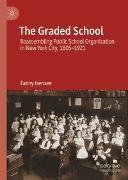Read more
“This pioneering study provides the first in-depth analysis of a taken-for-granted aspect of modern schooling: the grouping of children by age. Drawing on an original application of actor-network theory (ANT) within the history of education, Isensee presents rich insights into the cultural foundations of what we consider a ‘real’ school. An essential read for anyone interested in the deep-rooted structures—the so-called grammar of schooling—that continue to govern education up to this day.”
—Johannes Westberg, Full Professor of Theory and History of Education, University of Groningen, the Netherlands
This book examines the historical development of age-graded classrooms, a defining feature of modern public education that became embedded in the “grammar of schooling”—the fundamental organizational structures that shape how schools operate. Focusing on the implementation of gradation in New York City, the study traces the transformation of an urban school system from the nineteenth to the early twentieth century. Using actor-network theory as its analytical framework, the book explores how gradation emerged through complex assemblies of human and non-human actors along with the practical challenges of implementing graded systems, the educational concepts that supported these changes, and the administrative innovations required to manage increasingly complex school systems. Drawing on extensive archival research, this work illuminates how the age-graded classroom became a foundational element of US-American public education in rapidly growing urban centers.
Fanny Isensee is a postdoctoral researcher at Humboldt-Universität zu Berlin, Germany. Her research interests include the history of school organization, school routes and school transportation, small forms in education as well as the connections between history of knowledge and history of education.
List of contents
1. Classroom Organization and the Age Category.- 2. Making the School Grade.- 3. Tracing School Organization with Actor-Network Theory.- 4. The Emergence of the Graded Classroom.- 5. The Age-Graded Classroom as an Assembly of Actors.- 6. The (Re-)Assembled Classroom — Potentials, Obstacles, and Modifications.
About the author
Fanny Isensee is a postdoctoral researcher at Humboldt-Universität zu Berlin, Germany. Her research interests include the history of school organization, school routes and school transportation, small forms in education as well as the connections between history of knowledge and history of education.
Summary
This book examines the historical development of age-graded classrooms, a defining feature of modern public education that became embedded in the “grammar of schooling”—the fundamental organizational structures that shape how schools operate. Focusing on the implementation of gradation in New York City, the study traces the transformation of an urban school system from the nineteenth to the early twentieth century. Using actor-network theory as its analytical framework, the book explores how gradation emerged through complex assemblies of human and non-human actors along with the practical challenges of implementing graded systems, the educational concepts that supported these changes, and the administrative innovations required to manage increasingly complex school systems. Drawing on extensive archival research, this work illuminates how the age-graded classroom became a foundational element of US-American public education in rapidly growing urban centers.

